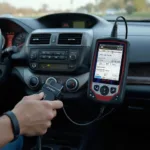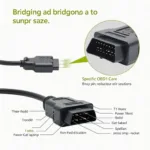Understanding the difference between OBD1 and OBD2 systems and knowing the years they were implemented is crucial for effective vehicle diagnostics. This guide provides a comprehensive overview of OBD1 OBD2 years, helping you navigate the complexities of these diagnostic systems.
The transition from OBD1 to OBD2 marked a significant shift in vehicle diagnostics. While OBD1 systems varied greatly between manufacturers, OBD2 standardized diagnostic procedures and connectors. This standardization simplified troubleshooting for mechanics and vehicle owners alike. Knowing which system your vehicle utilizes is the first step to accurate diagnostics.
Understanding OBD1 and Its Varied Implementation
OBD1, or On-Board Diagnostics generation one, was introduced in the late 1980s and early 1990s. Unlike its successor, OBD1 lacked standardization. Each manufacturer had its own unique diagnostic connectors, protocols, and trouble codes. This lack of uniformity made diagnosing vehicle issues more challenging, often requiring specialized equipment for each make and model. Identifying the specific OBD1 system used in a particular vehicle is essential for proper diagnosis.
Navigating the Challenges of OBD1 Diagnostics
OBD1 systems often relied on blinking check engine lights to communicate trouble codes. Deciphering these blinking codes required consulting vehicle-specific manuals or using specialized code readers. The absence of a universal standard made OBD1 diagnostics time-consuming and often frustrating.
The Standardization of OBD2: A Leap Forward in Diagnostics
In 1996, the Environmental Protection Agency (EPA) mandated the implementation of OBD2 in all light-duty vehicles sold in the United States. This marked a turning point in vehicle diagnostics. OBD2 provided a standardized 16-pin diagnostic connector, universal trouble codes (DTCs), and standardized communication protocols. obd2 scanner will it read obd1 ford codes addresses the compatibility issues between these two systems.
Key Benefits of OBD2 Standardization
The introduction of OBD2 simplified vehicle diagnostics significantly. The universal connector and standardized DTCs made it easier for mechanics and vehicle owners to identify and troubleshoot problems. This standardization also facilitated the development of affordable and versatile OBD2 scanners.
OBD1 OBD2 Years: Identifying Your Vehicle’s System
Determining whether your vehicle uses OBD1 or OBD2 depends primarily on its model year. Generally, vehicles manufactured before 1996 in the US are equipped with OBD1, while those manufactured from 1996 onwards have OBD2. However, there can be exceptions, particularly with some early 1996 models. Checking your vehicle’s owner’s manual or the emissions sticker under the hood can provide confirmation. is a 91 k2500 obd2 can help you specifically with that vehicle model.
Variations and Exceptions in OBD1 OBD2 Years
While the 1996 cutoff is generally accurate, some variations exist. Certain vehicle manufacturers adopted OBD2 earlier than the mandated date. Conversely, some 1996 models might still have OBD1 systems. It’s crucial to verify your vehicle’s specific system to avoid diagnostic errors. obd1 to obd2 adapter ford offers solutions for vehicles with OBD1 systems.
“Knowing the exact OBD system of your vehicle is paramount for accurate diagnostics. Don’t rely solely on the model year; always verify,” advises John Smith, Senior Automotive Diagnostic Technician at AutoTech Solutions.
Utilizing OBD2 Scanners for Enhanced Diagnostics
OBD2 scanners provide a wealth of information beyond simply reading trouble codes. They can display real-time data from various sensors, allowing for in-depth analysis of vehicle performance. These scanners can also be used to clear trouble codes after repairs have been made.
“Modern OBD2 scanners are invaluable tools for both professionals and DIY enthusiasts. They empower users with the ability to diagnose and understand their vehicles better,” adds Maria Garcia, Lead Engineer at Diagnostic Systems Inc. scanner obd1 y obd2 craftsman discusses a specific scanner model and its capabilities.
Conclusion
Understanding OBD1 OBD2 years is fundamental for efficient vehicle diagnostics. While OBD1 systems present challenges due to their lack of standardization, OBD2 offers a simplified and universal approach. Accurately identifying your vehicle’s system is the first step towards effective troubleshooting and maintenance.
“Don’t underestimate the importance of knowing your vehicle’s OBD system. It’s the key to unlocking a wealth of diagnostic information,” emphasizes David Lee, Automotive Instructor at Apex Technical Institute. obd2 h22a swap provides further insight into OBD2 applications.
For support, contact us via WhatsApp: +1(641)206-8880, Email: [email protected] or visit us at 789 Elm Street, San Francisco, CA 94102, USA. We offer 24/7 customer support.

